Syrian Arabic (اللّهجة السّورية – al-Lahja as-Sūriyya) is a central dialect within the Levantine Arabic family, widely spoken across Syria and the Syrian diaspora worldwide. As one of the most prominent dialects in the Arab world, it has more than 17 million speakers, including those in neighboring countries such as Lebanon, Jordan, Turkey, and further across Europe and the Americas. Syrian Arabic has been influenced by historical and geographical factors, including Turkish, French, Kurdish, and Aramaic, due to Syria’s rich cultural past, shaped by the Ottoman and French colonial periods.
This dialect shares similarities with other Levantine Arabic varieties, such as Lebanese and Palestinian Arabic, but it stands out with its own unique features in pronunciation, vocabulary, and informal usage. While Modern Standard Arabic (MSA) is used in formal contexts like writing, education, and media, Syrian Arabic thrives in daily interactions and informal settings. It plays a significant role in Syrian popular culture, especially through TV dramas, music, and social media, which contribute to its prominence in the Arab-speaking world.
Syrian Arabic has also been shaped by its diaspora, with speakers adapting and integrating local influences wherever they reside. While the dialect may vary between regions, with notable differences between urban, rural, and Bedouin forms, it remains mutually intelligible across the Levant. The language is both dynamic and evolving, blending traditional elements with modern innovations, making it a key dialect for learners interested in connecting with the broader Arabic-speaking world.
Table of Contents
Important Facts About Syrian Arabic
| Category | Details |
|---|---|
| Name | Syrian Arabic (اللّهجة السّورية – al-Lahja as-Sūriyya) |
| Also Known As | Syrian Levantine, Syrian Dialect |
| Language Family | Semitic → Central Semitic → Arabic → Levantine Arabic → Syrian Arabic |
| Region Spoken | Syria (Damascus, Aleppo, Homs, Hama, Latakia, and other cities), as well as the Syrian diaspora in Lebanon, Jordan, Turkey, Europe, and the Americas |
| Number of Speakers | Over 17 million (including diaspora communities) |
| Status | Spoken in daily life, Modern Standard Arabic (MSA) is used in formal writing, education, and media |
| Relation to MSA | Shares core grammar and vocabulary; differs notably in pronunciation, idiomatic expressions, and informal usage |
| Influences | Turkish, French, Kurdish, Aramaic, and English, shaped by Ottoman and French colonial periods and modern migration |
| Written Form | Rarely written, MSA is used for formal contexts, though Syrian Arabic may appear informally in texts, social media, and pop culture |
| Media Use | Widely used in Syrian TV dramas, films, and music, Modern Standard Arabic (MSA) is used for news, formal literature, and education |
| Mutual Intelligibility | Syrian Arabic is commonly heard in TV dramas, films, and music, while MSA is primarily reserved for news broadcasts, formal writing, and educational settings. |
Syrian Arabic, a central dialect of the Levantine Arabic continuum, is known for its melodious tone and cultural reach through popular media. It shares linguistic roots with neighboring dialects but reflects a unique history of multilingual influence and regional diversity.
Who Speaks Syrian Arabic?
Syrian Arabic is spoken by the population of Syria, including in major cities such as Damascus, Aleppo, Homs, and Latakia, as well as by Syrian communities in neighboring countries and across the global diaspora. Large numbers of Syrian Arabic speakers also live in Jordan, Lebanon, Turkey, and increasingly in Europe and North America due to migration and displacement caused by conflict. The dialect reflects Syria’s diverse cultural and regional makeup, with noticeable variation between urban, rural, and Bedouin forms, while remaining broadly intelligible across the Levant.
Differences Between Syrian Arabic and Modern Standard Arabic
Syrian Arabic differs from Modern Standard Arabic (MSA) in various ways, particularly in pronunciation. One of the most noticeable differences is the pronunciation of certain consonants. For instance, the letter ق (qāf) is pronounced as a glottal stop [ʔ] or [k] in Syrian Arabic, especially in urban areas, whereas MSA retains the classical [q] sound. Additionally, sounds like ج (jīm) are often pronounced as [ʒ] in Syrian Arabic (similar to the “s” in “measure”), in contrast to the MSA pronunciation [dʒ]. These phonetic distinctions give Syrian Arabic a softer and more fluid sound compared to the formal tone of MSA.
Another key difference lies in vocabulary and expression. Syrian Arabic incorporates numerous loanwords from languages such as Turkish, French, and English due to historical and cultural interactions. For example, the word “telephone” is pronounced “tilifoun” in Syrian Arabic, while MSA uses the term “hātif.” Furthermore, everyday expressions and slang in Syrian Arabic are not found in MSA, contributing to the dialect’s more casual, conversational nature. This makes Syrian Arabic much more dynamic and informal, whereas MSA is more rigid and standardized, particularly in formal contexts like media and literature.
Grammar in Syrian Arabic also differs from MSA, with simpler and more flexible structures. For instance, the verb “to want” in MSA is “urīdu,” while in Syrian Arabic, it becomes “biddi.” Syrian Arabic also tends to use a more relaxed approach to word order, allowing for Subject-Object-Verb (SOV) constructions, which is less common in the more rigid Subject-Verb-Object (SVO) word order of MSA. While MSA is the language of formal writing, news, and education, Syrian Arabic is used primarily in informal, everyday speech, making it easier for speakers to communicate with each other in casual settings.
Linguistic Features of Syrian Arabic
Syrian Arabic, like other Levantine dialects, has several linguistic features that distinguish it from Modern Standard Arabic (MSA) and other regional dialects. One of the most significant features is its phonetic system. For example, the letter ق (qāf) is often pronounced as a glottal stop [ʔ] in urban areas of Syria, such as Damascus, while in rural or Bedouin regions, it may be pronounced as a [k] sound. The letter ج (jīm) is also pronounced differently from MSA, often as [ʒ] (similar to the “s” in “measure”), whereas MSA uses [dʒ]. These phonetic changes give Syrian Arabic a distinct and soft sound, setting it apart from the more formal tone of MSA.
Another important feature of Syrian Arabic is its vocabulary, which includes many loanwords from other languages. This reflects the country’s history of foreign influence. For example, Syrian Arabic uses the word “tilifoun” for “telephone,” borrowing from French, whereas MSA would use “hātif.” Similarly, “bēt” is commonly used in Syrian Arabic for “house,” which is derived from the classical Arabic “bayt,” but it’s often used in a more colloquial context. This blending of local, regional, and foreign influences makes the dialect rich in vocabulary, but also means it is constantly evolving.
In terms of grammar, Syrian Arabic tends to simplify and modify some structures found in MSA. For example, the verb “to want” in MSA is “urīdu,” while in Syrian Arabic, it is shortened to “biddi.” Syrian Arabic also has a more flexible sentence structure, often employing Subject-Object-Verb (SOV) rather than the more rigid Subject-Verb-Object (SVO) word order used in MSA. Furthermore, Syrians often use contractions and blends in speech, such as “mā biddi” (I don’t want) instead of the MSA equivalent “lā urīdu.” These relaxed grammatical rules make the dialect easier to use in informal contexts and add to its rhythmic flow in conversation.
How Can I Learn Syrian Arabic?
Syrian Arabic online and in-person courses are excellent starting points for anyone seeking their first exposure to the dialect. Several other valuable resources and programs support learners at all levels, whether through structured courses, online platforms, or immersive in-person experiences.
Here are a few recommended sources for learning Syrian Arabic:
1. Study Levantine Arabic Platform
Enroll in the Study Levantine Arabic‘ intensive Syrian Arabic courses, which offer 20 hours of instruction per week. These courses allow students to quickly acquire Arabic skills and finish a full 80-hour course in just four weeks. Intensive options are offered in both Modern Standard Arabic and Palestinian Arabic (Ammiyya), Syrian, and Levantine Arabic (Shami Dialect).
2. Study Arabic Online Courses
Study Arabic Online offers courses in Levantine Arabic (Ammiyya or Shami Arabic), which includes Palestinian, Jordanian, Syrian, Lebanese, and Egyptian dialects, as well as Modern Standard Arabic. Our programs are designed for beginners and focus on practical conversation and everyday vocabulary, making learning Arabic from the comfort of your home or workplace easy. Ready to learn Arabic? Join our engaging online lessons taught by experienced instructors from Palestine, Jordan, Lebanon, Egypt, and Syria. Whether you’re a student, a professional, or just passionate about Arabic, our classes are designed for everyone. You’ll learn to speak Arabic confidently and connect with people from Arabic-speaking countries.
3. The Excellence Center in Europe
The Excellence Center in Europe provides various Arabic language programs, including Syrian dialect, for individuals eager to learn Arabic while immersing themselves in Europe’s rich cultural diversity. Whether you’re a student aiming to strengthen your language skills, a professional seeking to enhance cross-cultural communication, or a language enthusiast exploring Arabic dialects, our programs offer an immersive and engaging learning experience.
4. Study Arabic World
Study Arabic World offers a range of intensive programs designed to immerse you in the rich linguistic tapestry of the Arabic language. Our courses cover Palestinian, Jordanian, Syrian, Lebanese, and Egyptian Arabic dialects, along with Modern Standard Arabic. Crafted specifically for those with little to no Arabic proficiency, our programs aim to foster meaningful connections within local communities. Emphasizing practical conversations and everyday vocabulary, our curriculum facilitates easy and effective Arabic language learning, all from the comfort of your home or workplace.
5. Study Syrian Arabic Online Course
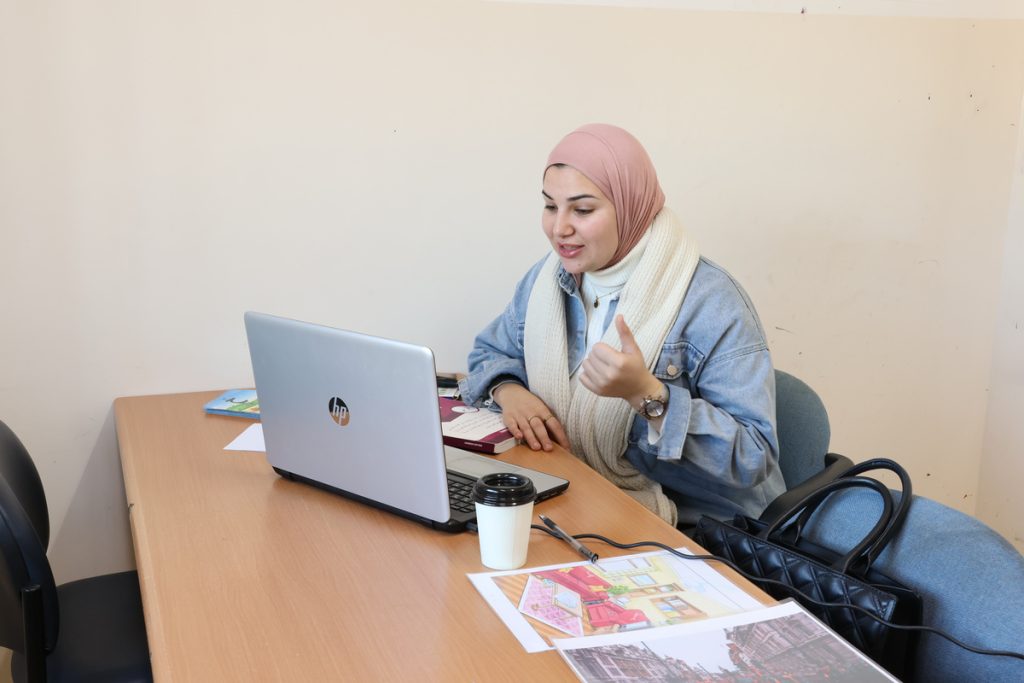
Syrian Online Course: The Study Syrian Arabic Online Program is a valuable opportunity for those who want to learn and study the increasingly relevant and critical dialect (also known as Ammiya, Shami, or Levantine Colloquial Arabic) and practice with other students. Shami Arabic is spoken by nearly 42 million people in four Arab countries: Jordan, Palestine, Lebanon, and Syria.
Additional Tips on Improving Syrian Arabic
A well-rounded approach to learning Syrian Arabic combines listening, speaking, reading, and cultural immersion. Consider the following strategies:
- Watch Syrian TV shows and films with subtitles to familiarize yourself with pronunciation and expressions.
- Use audio-based language apps or YouTube channels dedicated to Syrian Arabic.
- Engage in language exchange with native speakers via platforms like Tandem or HelloTalk.
- Take live classes (online or in-person) to get personalized instruction and practice speaking.
- Supplement with grammar books or phrasebooks focused on Syrian Arabic.
Top Places to Study Syrian Arabic for In-Person Lessons
If you want to deepen your understanding of Syrian Arabic, several excellent programs and institutions offer immersive and accessible learning experiences. From intensive in-person courses to flexible online platforms, these options cater to learners of all levels and provide valuable cultural insights alongside language instruction:
1. The Excellence Center in Palestine
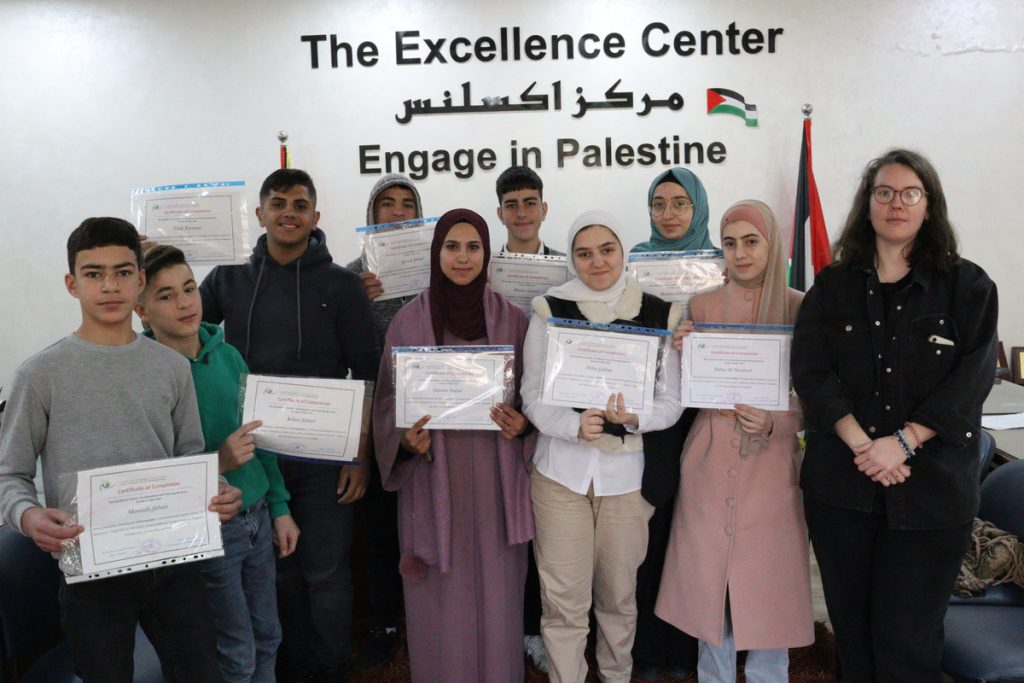
Study Syrian Arabic: Enroll in our top-tier language program and study Syrian Arabic at the Excellence Center! We are well known as one of the Levant’s best Arabic language schools. Our strategic location in Hebron (an affordable and bustling city in the West Bank) creates an ideal atmosphere to learn the Ammiya Arabic dialect (This dialect is spoken throughout Syria, Lebanon, Palestine, and Jordan).
2. The Excellence Center in Europe
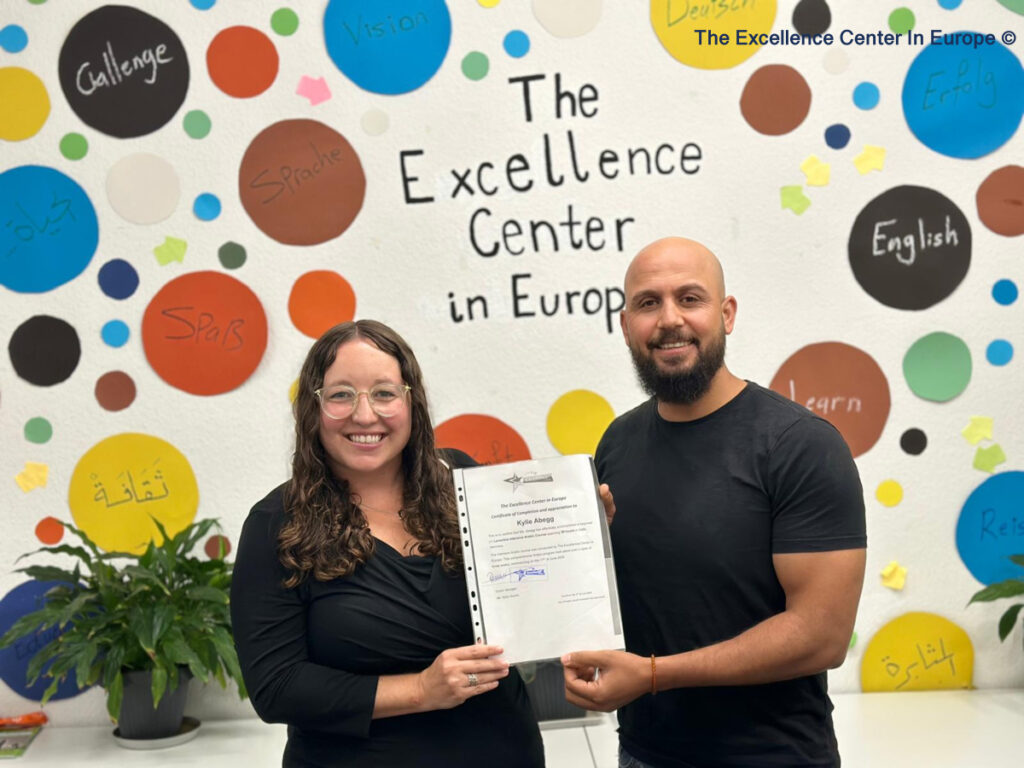
Study Syrian Arabic in Germany: Students can explore the language and culture of a diverse Arabic diaspora by choosing to study Syrian Arabic at the Excellence Center in Halle, Germany. The Excellence Center is a unique place where the German and Arabic languages and cultures converge. Many refugees, migrants, and asylum seekers live in Halle, creating a blend of cultures that demonstrates the utility of the Arabic language outside of the Middle East and North Africa.
3. Engage in Palestine
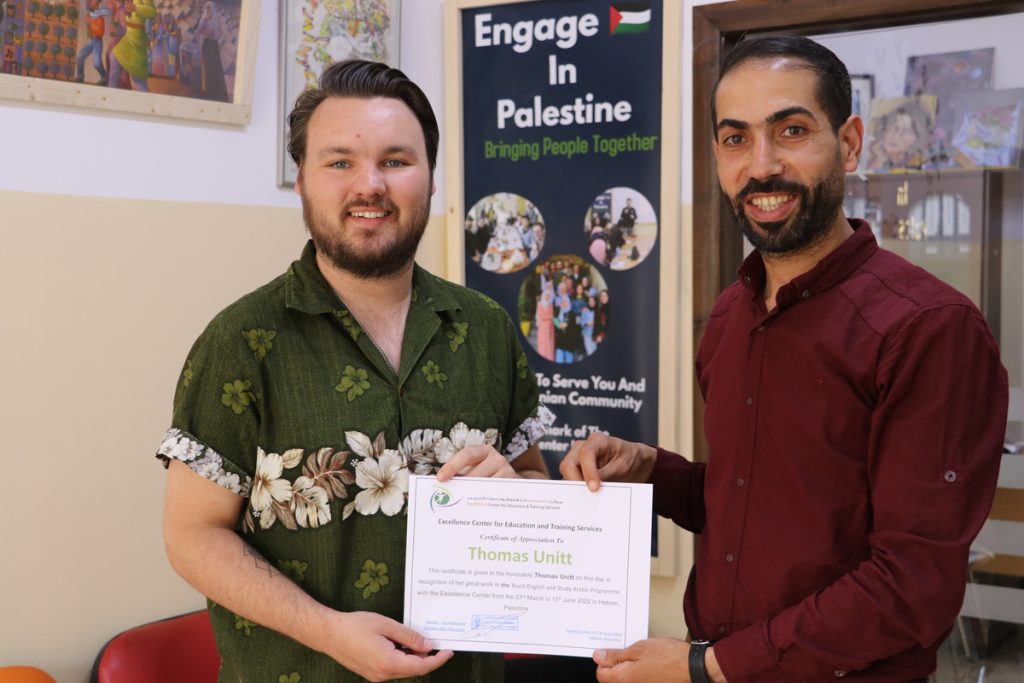
The Intensive Syrian Arabic Program, by Engage in Palestine, is an excellent opportunity for those wishing to learn the colloquial Syrian dialect of Arabic, connect with the wider Arabic diaspora, and immerse themselves in the diverse culture of the Levant. Engage in the West Bank offers courses at four levels and three intensities, depending on your needs.
4. Study in Palestine
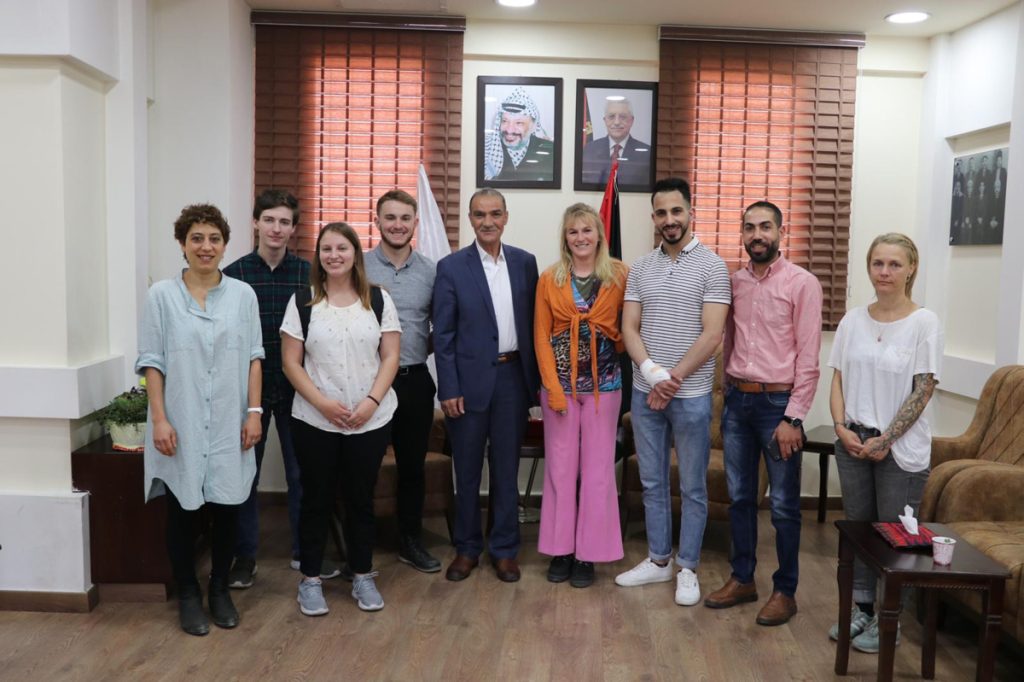
Join the premier Study in Palestine‘s language program to study Syrian Arabic at a top school in the bustling city of Hebron. Experience the ideal atmosphere for learning the Levantine dialect spoken in Syria, Lebanon, Palestine, and Jordan. Immerse yourself in the rich culture of Palestine and the Levant, and gain insight into the region’s history and current events while building meaningful relationships with the Palestinian community.
Common Syrian Arabic Phrases
| English | Arabic |
| Hello | مرحبا (marhaba) or اهلين (ahlayn) |
| Welcome | اهلا و سهلا (ahlan wa sahlan) |
| Response | اهلا فيك (ahlan feek) |
| Thank you | شكرا (shukran) or يسلمو (eeslamu) |
| Thanks to your hands | يسلمو يديك (eeslamu eedayk) |
| Good Morning | صباح الخير (sabah al kheir) |
| Response | صباح النور/ الورد (sabah al noor or al ward) |
| Good Evening | مسا الخير (masa al kheir) |
| Response | مسا النور (masa al noor) |
| See you later | بشوفك |
| Goodbye/Go in Peace | مع سلامة (ma’ salama) |
| Goodnight | تصبح الخير (tisbah al kheir) |
| Nice to Meet You | فرصة سعيدة (sharafna) or شرفنا (fursa sayeeda) |
| How Are You? (masculine) | كيف حالك (keefak) or كيفك (keef halak) |
| How Are You? (feminine) | كيف حالك (keefik) or كيفك (keef halik) |
| Good, thank God | تمام الحمدلله (tamam alhamduleelah) |
| Living | (عيش(ة (ayeesh–masc.) (ayeesha–fem.) |
| Fine | (منيح (ة (mineeh–masc.) (mineeha–fem.) |
| What’s the News/What’s New? | شو الاخبار (shu al akhbar) |
| Everything is good | كل شي تمام (kul shee tamam) |
| Enjoy the Food/Bon Appetite | صحه (saha) |
| Response | On your heart: على قلبك (ala qalbak) |
| Congratulations | مبروك (mabrook) |
| Thank you for your service | يعطيك العافية (yateek ala’feya) |
| How Old Are You? | قديش عمرك (qadesh umrak–masc/umrik–fem) |
| Where do you live? | (وين ساكن(ة (wayn sakan–masc/sakana–fem) |
| Where are you from? | من وين انت (min wayn inta–masc/inti–fem) |
| Do you speak Arabic? | بتحكي عرابي؟ (bitihky arabey) |
| Do you speak English? | بتحكي انجليزي (bitihky injleezey) |
| A little | شوي (shway) |
| Light/A small amount | حفيف (hafeef) |
| I swear to God | والله (wallah) |
| God Willing | Enjoy the Food/Bon Appétit |
| Praise God | Enjoy the Food/Bon Appétit |
| God Willed | ماشاالله (masha’allah) |
| Really or Seriously | عنجد (anjad) |
Conclusion
In conclusion, Syrian Arabic is a dynamic and influential dialect within the Levantine Arabic family, with a rich cultural and historical heritage. Spoken by over 17 million people, including those in Syria and its vast diaspora across the globe, it plays a vital role in everyday communication, media, and cultural expressions. Although Syrian Arabic shares common roots with Modern Standard Arabic (MSA), it stands apart with its distinct phonetics, vocabulary, and grammar, reflecting both the region’s linguistic diversity and historical influences from languages such as Turkish, French, Kurdish, and Aramaic.
As a colloquial language, Syrian Arabic thrives in informal settings and has become an essential part of popular culture through TV shows, films, and music. Despite the differences from MSA, the dialect is mutually intelligible across the Levant, making it accessible and practical for communication within the region and the broader Arabic-speaking world. The continued evolution of Syrian Arabic, particularly through the diaspora, underscores its adaptability and importance in maintaining connections across generations and geographies.
For learners, Syrian Arabic offers a unique and engaging experience, blending traditional and modern elements. With various resources available for both in-person and online learning, aspiring speakers can dive into this vibrant dialect and gain deeper insights into the cultural and social dynamics of the Levant. Whether through formal courses, language exchange, or cultural immersion, mastering Syrian Arabic opens doors to richer interactions with Arabic speakers and a better understanding of the diverse and historical region of Syria.
